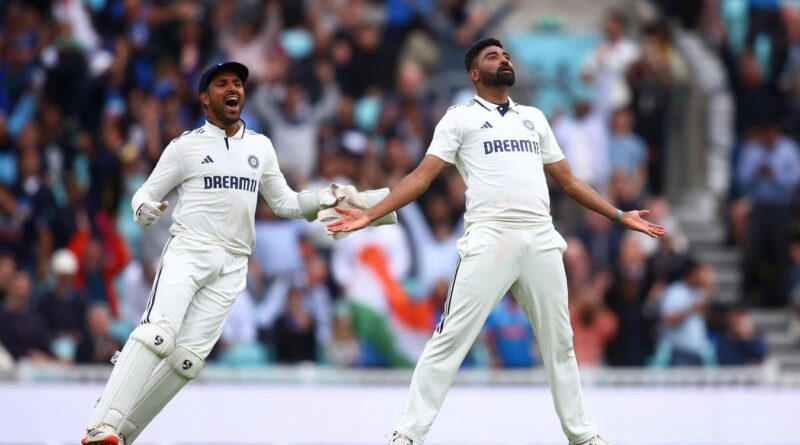India-ENGLAND series underlines the urgency to maintain a test cricket alive
Typically, Monday morning in London, one of the largest goals in the 148 -year history of the test cricket, a traditional five -day sport format that feels like a relic for a quieter time, still attracts despite its future.
Naturally, a lot of time is invested in a game that can withstand the equivalent of the working week. And a lot of that time can feel, many days when you question the monitoring of something so tiring and contact with the sugar of modern life.
But sometimes test the cricket causes something so absolutely gliding, unrivaled in sports. When the surface is tense, the inner slowness increases the excimion and makes every delivery so nervous that you could reduce the tension in the air with a knife.
In the test cricket there is a payout that exceeds its knock -OFF shorter version.
And so this method had to complete the riveting series of five tests between the engine and the India in the oval. By the end of the day, Poiseed was gently, with all possible results, and what followed will never forget.
India required an unforgettable test victory (Ben Hoskins/Getty Images for Surrey CCC)
Getty Pictures for Surrey CCC
In front of a tense sold out crowd, many of which supported Turty, India pulled the smallest edge of victory in the test cricket to desperately draw a series of 2-2.
They won for six runs after the workhorse Quick Mohammed Siraj – who was inspired by his hero Ronaldo – completed one of the most incgatible performances that appeared in a cricket field when he cleaned Bows Atkinson, who threatened the unlikely late robbery in England.
There were also mixed scenes of unfit Chris Woakes bravely coming to bat on No. 11 with his play attracting his left arm in a sling due to a dislocated shoulder.
Woakes probably did not turn one – Russian and bad – introduce a table tennis player – but he did not end up facing delivery he did at every time to add to an incredible drama.
It was probably the best test match and the series was played by Singe The Legendary 2005 Ashes, an iconic series that captured Australia and England far behind traditional cricket fans.
The 25 -day series ended with 56 minutes of pure tension that David Fincher could not even think of from the director’s chair.
While the test cricket continues to flourish between the cricket power – remains the cornerstone of billions of -dollary broadcast shops in Australia and England – the future of format is unclear outside.
The working group among the most powerful sports administrators is created to solve the main cricket problems, including the future of the test cricket.
As I said last month, representatives of Big Three will probably be part of a working group led by New Zealand Roger Twose. The working group also contains chiefs of a smaller complete member of Zimbabwe and the Associate Nation Namibia – a country that has at the World Cup 2027 at 2027.
Twose has already taken some of the source that contributed to smaller works that focused on thorny problems, such as the program of the future tour and opportunities to play smaller countries that often avoid the Power Trio.
Perhaps the biggest problem facing the working group will be a radical plan of the division of 12 test nations into two divisions. At the recent meetings of the International Criket Council in Singapore, the feelings of administrators prevailed that two divisions were inevitable.
While the World Championship in nine teams is a good starting point to add a larger context, the structure of the league, which would also add Zimbabwe, Ireland and Afghanistan, is widely perceived as needed.
There are several points of messages. Promotions and meetings are pushed by smaller nations and undeniably add a large drama, but the large three nations are seemingly deceived about the prospect of being degraded.
If they are not in the same division, the series would continue – due to financial shares – but outside the league that WoW creates some chaos.
“(Two divisions) is a smart way of cramming in more” big “matches and justification,” the senior administration told me.
“Every participating team must get a decent slug of money to justify the cost of a test cricket. You must have a viable A-team and first-class system and that they all need funding.
The bat came to the bat (photo Gareth Cally/Getty Images) came out on the bat.
Getty pictures
It seems that the revived test matches – where Big Three has provided financial support to smaller nations – has Stally, learns, but should be part of a working group remitting.
The four -day test cricket, which was played by Singe 2017, will also be analyzed with support from smaller nations that want to be sanctioned for another WTC cycle. The shortened test version helps to alleviate financial tensions for those financially affected countries trying to cover the host costs.
While the test cricket is very popular and profitable on the traditional market of England and Australia, it has decreased elsewhere where the three -hour T20 format was a growth engine of sport.
No new nations are expected, with a test cricket unlikely to spread again.
“The T20 is a Caribbean thing, it has helped keep the flame alive for cricket,” said West India Criket Chris Dehring. “The world cricket is in balance when it comes to where it goes.
“When you use the term cricket, now you don’t know the tops where you talk about a test cricket or T20.
“However, our biggest investment in the Caribbean is our first -class system. We are still quite optimistic about the future of the test cricket.”
